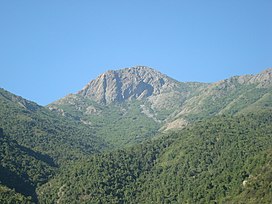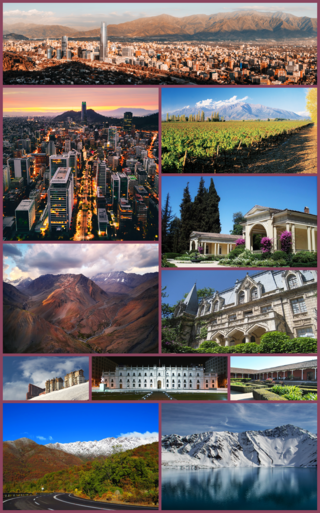
Santiago Metropolitan Region is one of Chile's 16 first-order administrative divisions. It is the country's only landlocked administrative region and contains the nation's capital, Santiago. Most commercial and administrative centers are located in the region, including Chile's main international airport, Arturo Merino Benítez International Airport.

Avellanita is a monotypic plant genus of the family Euphorbiaceae. The sole species is Avellanita bustillosii, endemic to Chile. A specific locus of occurrence is in the La Campana National Park of central Chile and amid the adjoining Cerro La Campana and in the Laguna Aculeo area and its southern distribution is located in Chancon, close to Rancagua. Regarding the use of its seeds, it has been pointed out that its "small hazelnuts" are edible.

Jubaea is a genus of palms with one species, Jubaea chilensis, commonly known in English as the Chilean wine palm or Chile cocopalm, and palma chilena in Spanish. It is native to southwestern South America and is endemic to a small area of central Chile between 32°S and 35°S in southern Coquimbo, Valparaíso, Santiago, O'Higgins, and northern Maule regions.

La Campana National Park is located in the Cordillera de la Costa, Quillota Province, in the Valparaíso Region of Chile. La Campana National Park and the Vizcachas Mountains lie northwest of Santiago. This national park covers approximately 80 square kilometres (31 sq mi) and is home to one of the last palm forests of Jubaea chilensis, which prehistorically had a much wider distribution than at present. Another attraction is the Cerro La Campana, which lends its name to the park. In 1834 Charles Darwin climbed this mountain, during the second voyage of HMS Beagle.
La Campana-Peñuelas is a Biosphere Reserve located in west-central Chile. which includes La Campana National Park and the Lago Peñuelas National Reserve. Forests within the La Campana-Peñuelas are habitats for the Chilean Wine Palm, Jubaea chilensis, an endangered palm, which had a much broader distribution prior to modern times.

Maytenus boaria (mayten) is an evergreen tree of the family Celastraceae, native from South America, up to 20 m (66 ft), 80 cm (31 in) diameter, straight trunk. It occurs naturally approximately from 30 to 50°S: Chile.

Kageneckia oblonga is a species of plant in the family Rosaceae. It is endemic to Chile. K. oblonga is an evergreen tree. It grows from Coquimbo to Malleco. Example occurrences are found specifically found in central Chile within the La Campana National Park and Cerro La Campana forest areas. In these areas the endangered Chilean Wine Palm, Jubaea chilensis is an associated tree species.

Palm syrup is an edible sweet syrup produced from the sap of a number of palms. It is produced in the Canary Islands and coastal regions of South America.
The Vizcachas Mountains is a mountain range northwest of Santiago, in the Santiago Metropolitan Region, Chile. It is part of the Chilean Coast Ranges System.
The Ocoa Valley is a landform in central Chile located by the La Campana National Park. This valley is a locus where considerable archaeological recovery has taken place, yielding considerable finds of pre-European contact period. According to Dallman and Hogan, some of the greatest stands of the endangered Chilean Wine Palm, Jubaea chilensis are found on the slopes of La Campana that rise up from the Ocoa Valley.
Puya coquimbensis is a species in the family Bromeliaceae. This species is a rare plant found in certain portions of Chile including Punta Teatinos and Cerro La Campana. In La Campana National Park P.coquimbensis is associated with the endangered Chilean Wine Palm, Jubaea chilensis, which palm prehistorically had a much wider distribution.

Puya venusta is a species of flowering plant in the family Bromeliaceae. This species is a rare plant endemic to certain areas of Chile including Punta Teatinos and Cerro La Campana. In La Campana National Park, P. venusta is associated with the endangered Chilean Wine Palm, Jubaea chilensis, a palm that prehistorically had a significantly wider distribution.
Cerro El Roble is a mountain in central Chile. Much of the land area associated with this mountain was incorporated into the La Campana National Park in the late 1990s. A station of the National Astronomical Observatory of Chile, Cerro El Roble Observatory is located at the top of this mountain.
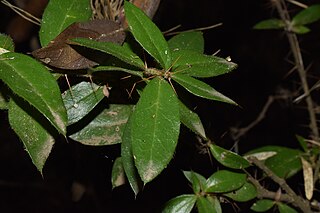
Dasyphyllum excelsum is a species of flowering plant in the family Asteraceae. This species is endemic to Chile, occurring from Quillota to Cauquenes between 190 and 800 m above sea level, a specific location of occurrence being in central Chile within the Cerro La Campana forests in association with the endangered Chilean wine palm, Jubaea chilensis.
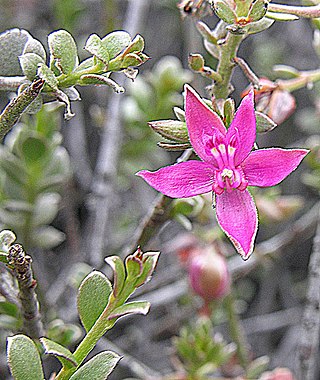
Krameria cistoidea is a perennial shrub in the plant family Krameriaceae. The biological action of genus members is caused by the astringent rhataniatannic acid, which is similar to tannic acid. Members of Krameria are found across the Americas, with most native to the tropical regions. An example occurrence is in the Cerro La Campana of central Chile, where it is found in association with the Chilean Wine Palm, Jubaea chilensis. They are perennial shrubs which act as root parasites on other plants. The flowers have glands called elaiophores which produce a lipid which is collected by bees of the genus Centris as they pollinate the flowers.
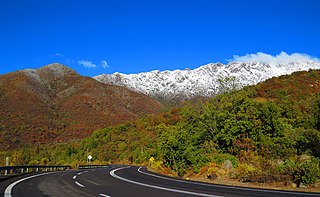
Cuesta La Dormida is a mountain in central Chile. Some of the forested mountain area of Cuesta La Dormida has been added to the La Campana National Park in order to achieve protection for the Jubaea and other endangered species. Forests on Cuesta La Dormida provide habitat for a number of bird and mammal species in addition to the flora mosaic itself.
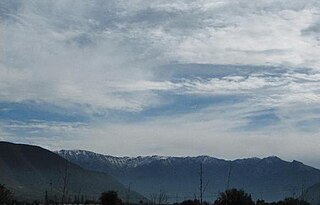
Chicauma is a mountain range in central Chile. This locale is noted for the impact of a large meteor noted in a report from 1916. The range is also termed Alto de Chicauma or Sierra de Chicauma. A portion of the Chicauma has been added to the La Campana National Park.
Retanilla trinervia is a species of actinorhizal plant within the family Rhamnaceae; this dicotyledon flora is a shrub or small tree. R. trinervia is notable for its ability to fix nitrogen. This species mainly occurs in the near coastal forests and arid shrubland of Chile. Example occurrences are found in the mountains of central Chile; for example, it occurs in the La Campana National Park in association with Acacia caven and Jubaea chilensis. as well as other proximate areas of central Chile.
Clinopodium chilense, synonyms including Satureja gilliesii, is a plant in the family Lamiaceae. C. chilense is endemic to central Chile. It is found in the La Campana National Park area, in association with the endangered Chilean wine palm, Jubaea chilensis.
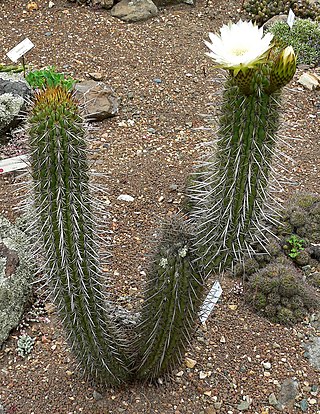
Leucostele chiloensis is a species of cactus native to South America; genus members are known as hedgehog cacti, sea-urchin cactus or Easter lily cactus.
